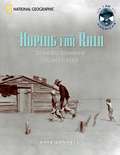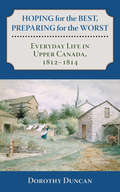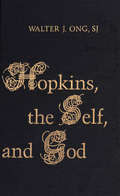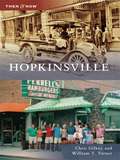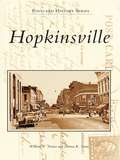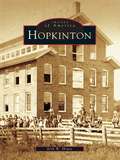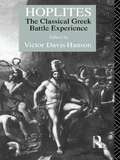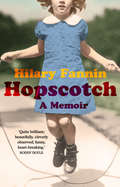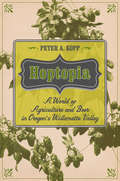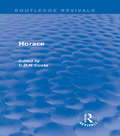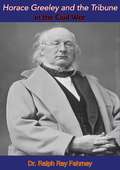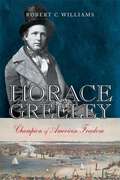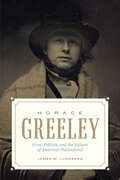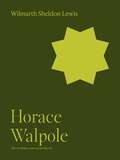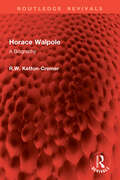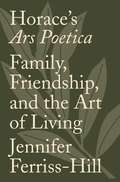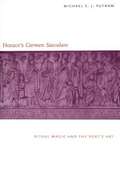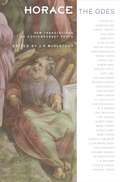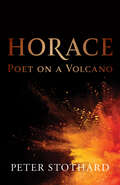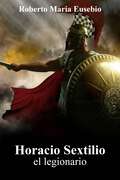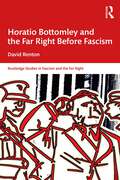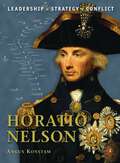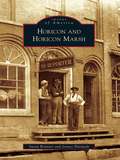- Table View
- List View
Hoping for Rain: The Dust Bowl Adventures of Patty and Earl Buckler (I Am American)
by Kate ConnellLike many farmers living in the Great Plains during the 1930s, the Bucklers are ravaged by months of dust storms and drought. Out of desperation, they travel West with their children, Patty and Earl, in hopes of finding new prosperity. Through letters and diary entries written by the Buckler children, readers witness the disaster of the Dust Bowl and the countless days spent wishing for an end to the drought - and their hunger. As they travel across the country, young Earl searches for work so he can help provide for the family. using the children's first-person accounts as well as period illustrations and photographs, the book accurately depicts the devastating effects of the Dust Bowl in the 1930s and '40s.
Hoping for the Best, Preparing for the Worst: Everyday Life in Upper Canada, 1812–1814
by Dorothy DuncanAn examination of Upper Canadian life at the dawn of a modern nation. Hoping for the Best, Preparing for the Worst explores the web of human relationships that developed in Upper Canada following the American Revolution, in the years leading up to the War of 1812, and during the conflict that raged for two years between the young United States and Britain, its former master. The book focuses on the families, homes, gardens, farms, roads, villages, towns, shops, and fabric of everyday life in this frontier society.Upper Canada was a land in transition as First Nations, fur traders, Loyalists, entrepreneurs, merchants, farmers, and newcomers from every walk of life formed alliances and partnerships based on friendship, marriage, respect, religion, proximity, and the desire to survive and prosper. With the declaration of war in June 1812, Upper Canadians realized that not only their lives but their future peace and prosperity were threatened. They responded with perseverance, loyalty, and unexpected acts of bravery.
Hopkins Self and God
by Walter J. OngIn these studies Professor Ong explores some previously unexamined reasons for Hopkins' uniqueness, including unsuspected connections between nineteenth-century sensibility and certain substructures of Christian belief.General Manley Hopkins was not alone among Victorians in his attention to the human self and to the particularities of things in the world around him, where he savoured the 'selving or 'inscape' of each individual existent. But the intensity of his interest in the self, as a focus of exuberant joy as well as sometimes of anguish, both in his poetry and his prose, marks him out as unique even among his contemporaries. In these studies Professor Ong explores some previously unexamined reasons for Hopkins' uniqueness, including unsuspected connections between nineteenth-century sensibility and certain substructures of Christian belief.Hopkins was less interested in self-discovery or self-concept than in what might be called the confrontational or obtrusive self - the 'I,' ultimately nameless, that each person wakes up to in the morning to find simply there, directly or indirectly present in every moment of consciousness. Hopkins' concern with the self grew out of a nineteenth-century sensibility which was to give birth to modernity and postmodernity, and which in his case as a Jesuit was especially nourished by the Spiritual Exercises of St Ignatius Loyola, concerned at root with the self, free choice, and free self-giving. It was also nourished by the Christian belief in the Three Persons in One God, central to Hopkins' theology courses and personal speculation, and very notable in the Special Exercises. Hopkins appropriated and intensified his Christian beliefs with new nineteenth-century awareness: he writes of the 'selving' in God of the Father, the Son, and the Holy Spirit. Hopkins' pastoral work, particularly in the confessional, dealing directly with other selves in terms of their free decisions, also gave further force to his preoccupation with the self and freedom. 'What I do,' he writes, 'is me.'Besides being concerned with the self, the most particular of particulars and the paradigm of all sense of 'presence,' the Spiritual Exercises in many ways attend to other particularities with an insistence that has drawn lengthy and rather impassioned commentary from the postmodern literary theorist Roland Barthes.Hopkins' distinctive and often precocious attention to the self and freedom puts him theologically far ahead of many of his fellow Catholics and other fellow Victorians, and gives him his permanent relevance to the modern and postmodern world.
Hopkinsville
by William T. Turner Chris GilkeyHopkinsville, the seat of Christian County, Kentucky, has experienced extensive change over the years. This volume studies the transition of a small-town culture from the days of dirt streets and horse-drawn vehicles to paved thoroughfares and motor traffic.
Hopkinsville
by William T. Turner Donna K. StoneHopkinsville is an enlightening collection designed to inform, entertain, 0and educate history buffs with images of the Pearl of the Pennyroyal." In this volume, authors William T. Turner and Donna K. Stone have teamed up to present more than 200 vintage images from Turner's personal collection to bring to life the people, events, communities, and industries that helped to shape and transform Hopkinsville. Portrayed in this postcard collection is a sampling of the city's past. Showcased are landmarks and people unique to this area, downtown memories, churches, schools and colleges, hotels, the Black Patch Tobacco War, and leisure activities. Personalities include Confederate president Jefferson Davis and world-famous clairvoyant Edgar Cayce, who made postcard views of the area."
Hopkinton (Images of America)
by Kirk W. HouseHopkinton has always been a rural town, but it grew up on pioneer industry. The mills on Wood River and other waterways form only part of this collection of Hopkinton images. You will also see town residents putting on plays, going to Camp Yawgoog by wagon, and fishing on Yawgoog Pond. Here is Hopkinton from the dawn of photography to the middle of the twentieth century: stone walls and farmsteads, horse-drawn buggies and early autos, and the fondly remembered Wood River Branch Railroad.
Hoplites: The Classical Greek Battle Experience
by Victor Davis HansonIncorporating research found in ancient literary, iconographic, epigraphic, and archaeological sources, this book explores the experiences of the soldiers who conducted battle on the small plains of ancient Greece.The volume, which draws on the accumulated expertise of nine American and British scholars, emphasizes the actual techniques of fighting and practical concerns as the use of commands, music in warfare, the use of "dog-tags", and ritual on the battlefield.
Hopscotch: A Memoir
by Hilary Fannin‘Quite brilliant; beautifully, cleverly observed; funny, heart-breaking.’ – Roddy DoyleHilary is four, not yet five, and she has a mother and a father and an older brother and sisters. She even has a name at home – Billy – that is different from her written-down name. But now that she is in Low Babies in the local convent school, it seems Hilary has something else called responsibilities. The world is a changing place. Hilary’s parents, themselves products of a country bathed in sanctifying grace, and presided over by leather-strapped Christian Brothers, wimpled nuns, and a strictly ingrained moral code, start to question their own life choices. As she begins to mature, Hilary’s perspective shifts from a confusing mosaic of half-understood conversations, bizarre rules and surreal religious symbolism, to a growing awareness of the eccentricities of the adult world around her, where money is tight, ideas are unorthodox and where living life to the full is the goal.As her parents’ unconventional lifestyle rubs against the grain of a pervasive Catholic society, the cracks begin to appear: siblings are expelled from school; final demands litter the hallway; and Hilary discovers the truth about the always-present but never-to-be-mentioned golden-haired lady. Hopscotch is a funny, poignant and beautifully written memoir, a spellbinding meditation on innocence, love and memory itself.
Hoptopia: A World of Agriculture and Beer in Oregon's Willamette Valley
by Peter A. KoppThe contents of your pint glass have a much richer history than you could have imagined. Through the story of the hop, Hoptopia connects twenty-first century beer drinkers to lands and histories that have been forgotten in an era of industrial food production. The craft beer revolution of the late twentieth century is a remarkable global history that converged in the agricultural landscapes of Oregon's Willamette Valley. The common hop, a plant native to Eurasia, arrived to the Pacific Northwest only in the nineteenth century, but has thrived within the region's environmental conditions so much that by the first half of the twentieth century, the Willamette Valley claimed the title "Hop Center of the World." Hoptopia integrates an interdisciplinary history of environment, culture, economy, labor, and science through the story of the most indispensible ingredient in beer.
Horace
by Emily GowersHorace's first book of Satires is his debut work, a document of one man's self-fashioning on the cusp between Republic and Empire and a pivotal text in the history of Roman satire. It wrestles with the problem of how to define and assimilate satire and justifies the poet's own position in a suspicious society. The commentary gives full weight to the dense texture of these poems while helping readers interpret their most cryptic aspects and appreciate their technical finesse. The introduction puts Horace in context as late-Republican newcomer and a vital figure in the development of satire and discusses the structure and meaning of Satires I, literary and philosophical influences, style, metre, transmission and Horace's rich afterlife. Each poem is followed by an essay offering overall interpretation. This work is designed for upper-level students and scholars of classics but contains much of interest to specialists in later European literature.
Horace (Routledge Revivals)
by C.D.N. CostaTwo thousand years after his death Horace is still recognised as a unique poet, having exerted marked influence on later European literature. This collection, first published in 1973, explores the different aspects of Horace’s poetic achievement in his main works: the Odes, Epistles¸ Satires and Ars Poetica. The essays, written by internationally-known scholars, include a discussion of the three worlds of the Satires, and a study of Horace’s poetic craft in the Odes – his greatest technical accomplishment. The final chapter is devoted entirely to Horace’s reputation in England up to the seventeenth century as ‘The Best of Lyrick Poets’, and concentrates on the many English translations which he inspired. The expert criticism is illustrated throughout by English translations from the original Latin texts. Horace will appeal to students and scholars of Latin poetry alike, as well as to those interested in the reception of classical literature throughout European history.
Horace Greeley and the Tribune in the Civil War
by Dr Ralph Ray FahrneyHorace Greeley (1811-1872) was an American author and statesman who was the founder and editor of the New York Tribune, among the great newspapers of its time. Born to a poor family in Amherst, New Hampshire, he was apprenticed to a printer in Vermont and went to New York City in 1831 to seek his fortune. In 1941 he founded the Tribune, which became the highest-circulating newspaper in the country through weekly editions sent by mail. Among many other issues, he urged the settlement of the American West, which he saw as a land of opportunity for the young and the unemployed, popularizing the slogan “Go West, young man, and grow up with the country.” He endlessly promoted utopian reforms such as socialism, vegetarianism, agrarianism, feminism, and temperance, while hiring the best talent he could find.In Horace Greeley and the Tribune, which was first published in 1936, Dr. Fahrney represents thorough research not only in the field of the New York Tribune, but in a great mass of printed material on the war. Well outlined and well written, it should prove both useful to the historian—offering the best guide through the mazes of the shuttlecock, loop-the-loop policy followed by the emotional editor of the Tribune—as well as to the student of journalism, who will find in it an explanation of how the most influential journal of the land in 1861 became one of the most distrusted four years later.
Horace Greeley: Champion of American Freedom
by Robert WilliamsFrom his arrival in New York City in 1831 as a young printer from New Hampshire to his death in 1872 after losing the presidential election to General Ulysses S. Grant, Horace Greeley (b. 1811) was a quintessential New Yorker. He thrived on the city’s ceaseless energy, with his New York Tribune at the forefront of a national revolution in reporting and transmitting news. Greeley devoured ideas, books, fads, and current events as quickly as he developed his own interests and causes, all of which revolved around the concept of freedom. While he adored his work as a New York editor, Greeley’s lifelong quest for universal freedom took him to the edge of the American frontier and beyond to Europe. A major figure in nineteenth-century American politics and reform movements, Greeley was also a key actor in a worldwide debate about the meaning of freedom that involved progressive thinkers on both sides of the Atlantic, including Margaret Fuller, Ralph Waldo Emerson, and Karl Marx.Greeley was first and foremost an ardent nationalist who devoted his life to ensuring that America live up to its promises of liberty and freedom for all of its members. Robert C. Williams places Greeley’s relentless political ambitions, bold reform agenda, and complex personal life into the broader context of freedom. Horace Greeley is as rigorous and vast as Greeley himself, and as America itself in the long nineteenth century.In the first comprehensive biography of Greeley to be published in nearly half a century, Williams captures Greeley from all sides: editor, reformer, political candidate, eccentric, and trans-Atlantic public intellectual; examining headlining news issues of the day, including slavery, westward expansion, European revolutions, the Civil War, the demise of the Whig and the birth of the Republican parties, transcendentalism, and other intellectual currents of the era.
Horace Greeley: Print, Politics, and the Failure of American Nationhood
by James M. LundbergA lively portrait of Horace Greeley, one of the nineteenth century's most fascinating public figures.The founder and editor of the New-York Tribune, Horace Greeley was the most significant—and polarizing—American journalist of the nineteenth century. To the farmers and tradesmen of the rural North, the Tribune was akin to holy writ. To just about everyone else—Democrats, southerners, and a good many Whig and Republican political allies—Greeley was a shape-shifting menace: an abolitionist fanatic; a disappointing conservative; a terrible liar; a power-hungry megalomaniac.In Horace Greeley, James M. Lundberg revisits this long-misunderstood figure, known mostly for his wild inconsistencies and irrepressible political ambitions. Charting Greeley's rise and eventual fall, Lundberg mines an extensive newspaper archive to place Greeley and his Tribune at the center of the struggle to realize an elusive American national consensus in a tumultuous age. Emerging from the jangling culture and politics of Jacksonian America, Lundberg writes, Greeley sought to define a mode of journalism that could uplift the citizenry and unite the nation. But in the decades before the Civil War, he found slavery and the crisis of American expansion standing in the way of his vision. Speaking for the anti-slavery North and emerging Republican Party, Greeley rose to the height of his powers in the 1850s—but as a voice of sectional conflict, not national unity. By turns a war hawk and peace-seeker, champion of emancipation and sentimental reconciliationist, Greeley never quite had the measure of the world wrought by the Civil War. His 1872 run for president on a platform of reunion and amnesty toward the South made him a laughingstock—albeit one who ultimately laid the groundwork for national reconciliation and the betrayal of the Civil War's emancipatory promise.Lively and engaging, Lundberg reanimates this towering figure for modern readers. Tracing Greeley's twists and turns, this book tells a larger story about print, politics, and the failures of American nationalism in the nineteenth century.
Horace Mann: A Biography
by Jonathan MesserliIn terms of biographers, Horace Mann has been fortunate, both in their number and good will. Grateful interpretations of his work began to emerge immediately after his death in 1859 and have abounded thereafter, reaching something of a climax in 1937, the centennial anniversary of his entrance into the common school reform movement. Six major biographies have been written, as have a score of lesser "short lives" and several book-length monographs on significant aspects of his career. In addition, a dozen doctoral students have mined his life for their special studies and more than a thousand admiring authors have published articles celebrating his contributions to the schooling of American children.
Horace Walpole (The A. W. Mellon Lectures in the Fine Arts #9)
by Wilmarth Sheldon LewisAn illuminating biographical study of the eighteenth-century English man of letters and patron of the artsHorace Walpole (1717–1797) was a collector, printer, novelist, arbiter of taste, and renowned writer of letters. In this book, eminent scholar Wilmarth Sheldon Lewis provides an unprecedented look at the life and work of one of England’s greatest men of letters. Lewis sheds light on Walpole’s relationships with his family and friends, his politics, his writings and printmaking activities, and his correspondence. Featuring portraits of Walpole, his relatives, and friends; images of Walpole's sketches and manuscripts; pages from books printed at Walpole’s Strawberry Hill Press; and views and plans of Strawberry Hill, the house, its rooms and furnishings, and its grounds, and accompanied by Lewis’s extensive annotations, this book provides an invaluable history of an extraordinary man.
Horace Walpole: A Biography (Routledge Revivals)
by R.W. Ketton-CremerHorace Walpole (1964) was widely acclaimed when it first appeared as the best life of Walpole yet written. It is scholarly and thorough, and since then there is no reason to believe that it has been displaced.
Horace's Ars Poetica: Family, Friendship, and the Art of Living
by Jennifer Ferriss-HillA major reinterpretation of Horace's famous literary manualFor two millennia, the Ars Poetica (Art of Poetry), the 476-line literary treatise in verse with which Horace closed his career, has served as a paradigmatic manual for writers. Rarely has it been considered as a poem in its own right, or else it has been disparaged as a great poet's baffling outlier. Here, Jennifer Ferriss-Hill for the first time fully reintegrates the Ars Poetica into Horace's oeuvre, reading the poem as a coherent, complete, and exceptional literary artifact intimately linked with the larger themes pervading his work.Arguing that the poem can be interpreted as a manual on how to live masquerading as a handbook on poetry, Ferriss-Hill traces its key themes to show that they extend beyond poetry to encompass friendship, laughter, intergenerational relationships, and human endeavor. If the poem is read for how it expresses itself, moreover, it emerges as an exemplum of art in which judicious repetitions of words and ideas join disparate parts into a seamless whole that nevertheless lends itself to being remade upon every reading.Establishing the Ars Poetica as a logical evolution of Horace's work, this book promises to inspire a long overdue reconsideration of a hugely influential yet misunderstood poem.
Horace's Carmen Saeculare: Ritual Magic and the Poet's Art
by Michael C. J. Putnam"This is the first book devoted to Horace's Carmen Saeculare, a poem commissioned by Roman emperor Augustus in 17 B. C. E. for choral performance at the Ludi Saeculares, the Secular Games. The poem is the first fully preserved Latin hymn whose circumstances of presentation are known, and it is the only lyric by Horace that we can be certain was first presented orally. Michael C. J. Putnam offers a close and sensitive reading of this hymn shedding new light on the richness and virtuosity of its poetry, on the many sources Horace drew on, and on the poem's power and significance as a public ritual.
Horace, The Odes: New Translations by Contemporary Poets (Facing Pages #1)
by HoraceThey have inspired poets and challenged translators through the centuries. The odes of Horace are the cornerstone of lyric poetry in the Western world. Their subtlety of tone and brilliance of technique have often proved elusive, especially when--as has usually been the case--a single translator ventures to maneuver through Horace's infinite variety. Now for the first time, leading poets from America, England, and Ireland have collaborated to bring all 103 odes into English in a series of new translations that dazzle as poems while also illuminating the imagination of one of literary history's towering figures. The thirty-five contemporary poets assembled in this outstanding volume include nine winners of the Pulitzer prize for poetry as well as four former Poet Laureates. Their translations, while faithful to the Latin, elegantly dramatize how the poets, each in his or her own way, have engaged Horace in a spirited encounter across time. Each of the odes now has a distinct voice, and Horace's poetic achievement has at last been revealed in all its mercurial majesty. In his introduction, J. D. McClatchy, the volume's editor and one of the translators, reflects on the meaning of Horace through the ages and relates how a poet who began as a cynical satirist went on to write the odes. For the connoisseur, the original texts appear on facing pages allowing Horace's ingenuity to be fully appreciated. For the general reader, these new translations--all of them commissioned for this book--will be an exhilarating tour of the best poets writing today and of the work of Horace, long obscured and now freshly minted. The contributors are Robert Bly, Eavan Boland, Robert Creeley, Dick Davis, Mark Doty, Alice Fulton, Debora Greger, Linda Gregerson, Rachel Hadas, Donald Hall, Robert Hass, Anthony Hecht, Daryl Hine, John Hollander, Richard Howard, John Kinsella, Carolyn Kizer, James Lasdun, J. D. McClatchy, Heather McHugh, W. S. Mervin, Paul Muldoon, Carl Phillips, Robert Pinsky, Marie Ponsot, Charles Simic, Mark Strand, Charles Tomlinson, Ellen Bryantr Voigt, David Wagoner, Rosanna Warren, Richard Wilbur, C. K. Williams, Charles Wright, and Stephen Yenser.
Horace: Poet on a Volcano (Ancient Lives)
by Peter StothardA biography of Horace, one of the most popular poets from antiquity, revealing the little-known man behind his famous lines &“Peter Stothard is a master of modern writing about ancient Rome, of vividly bringing to life its poetry and its poets.&”—Mary Beard Quintus Horatius Flaccus (65–8 BCE) wrote some of ancient Rome&’s greatest poetry, melding languages and cultures with youthful ideals and a realist&’s recognition of the dictatorial world around him. Horace is famed for his fine phrases, lyric sex, and guidance on how to live, but he was a poet maddened by war, and many of his most self-revealing poems have rarely been read. He could be sublime and obscene, amusing and abusive, a model of moderation and anything but. In this book, the first modern retelling of Horace&’s life, Peter Stothard follows the poet from his birth as the son of a formerly enslaved father through his rise to the highest circles of Roman society. He shines a light on how shattering experiences in the war to save Rome&’s republic shaped the loyal servant and revolutionary artist he became. With astute scholarship and sympathy, Stothard follows Horace&’s rise from humble beginnings to the social and political heights of the autocracy he had fought to prevent.
Horacio Sextilio: El legionario
by Roberto Maria EusebioEl recorrido del noble y joven Terencio que de simple legionario llega al trono senatorial. En Roma, corre el año 95 de Domiciano, un joven de noble familia se enamora de una joven plebeya. Su padre, Senador del Imperio, se opone a la relacion y envía al joven a las filas del ejército. Así comienza su camino, luchas, guerras, madurez y los golpes del destino, le forman un carácter honrado y noble, que lo llevarán a ocupar el sillón de su padre en el Senado.
Horatio Bottomley and the Far Right Before Fascism (Routledge Studies in Fascism and the Far Right)
by David RentonHoratio Bottomley and the Far Right Before Fascism examines Bottomley’s life and politics, and what made him one of the great figures of Edwardian life. During the first World War, his magazine John Bull sold two million copies a week. Bottomley addressed huge crowds urging them to wage a way of extermination against ordinary Germans. The first chairman of the Financial Times, the inspiration for Toad in The Wind in the Willows, Bottomley was also a major figure in post-1918 politics, urging Conservative voters to dump their leaders and try something new. This carefully researched biography, the first new life of Bottomley for 50 years, shows how he began on the centre-left of Edwardian politics and then moved to the margins, becoming a leading figure on the Edwardian far right, and pre-empting the non-fascist far right of our own days. This book will appeal to scholars and students with interests in political history, fascism and the far right.
Horatio Nelson
by Peter Dennis Angus KonstamThe most famous admiral in history, Horatio Nelson's string of naval victories helped secure Britain's place as the world's dominant maritime power, a position she held for more than a century after Nelson's death. A young officer during the American Revolution, Nelson rose to prominence during Britain's war with Revolutionary France, becoming a hero at the battle of Cape St. Vincent. He went on to win massive victories at the Nile and Copenhagen, before leading the British to their historic victory at Trafalgar in 1805. But, in that moment of his greatest glory, Nelson was struck down by a French sharpshooter. Today Nelson is revered as an almost mythical figure - a naval genius and a national hero. He was also a deeply flawed individual whose vanity, ego and private life all threatened to overshadow his immense abilities. This book reveals the real Nelson.From the Trade Paperback edition.
Horicon and Horicon Marsh (Images of America)
by Susan Brunner Jennee HarmuthThe city of Horicon has grown beyond its mill town roots to become home to John Deere, Gardner Manufacturing, and many community events. Meanwhile, Horicon Marsh has loomed to the north with its own story to tell. Over the years, what was once the land of the Winnebagos has been flooded, drained, dredged, and farmed. However, thanks to a restoration movement that began in the 1920s, Horicon Marsh stands today as the largest freshwater cattail marsh in the United States.
